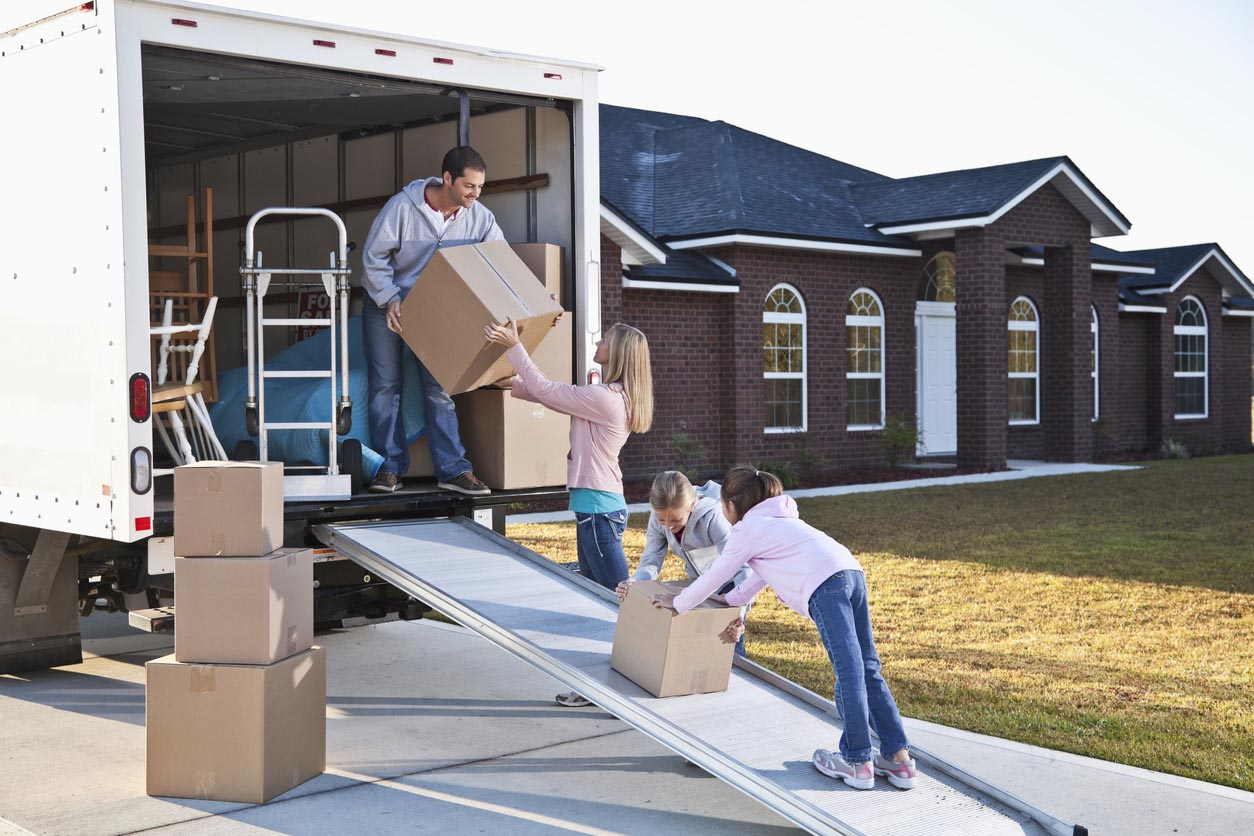We may earn revenue from the products available on this page and participate in affiliate programs. Learn More ›
It’s almost impossible to avoid moving at some point, but a cross-country move is a beast in its own right. The best way to move across the country is to do plenty of planning, preparation, scheduling, and coordinating ahead of time. From finding a new place to live to canceling subscriptions and forwarding mail, moving across the country or moving to another state is no simple task. This moving checklist helps explain each step in simple terms so homeowners and renters can ensure they check all the boxes and that no stone is left unturned. Homeowners or renters can read this guide to learn how to move across the country cheaply, how to hire the right moving company, how to travel to a new destination efficiently, and find out some packing tips for a smooth move. Understanding these steps before the big move can help boost confidence and prevent missteps or major mishaps.

Smart shipping. Easy tracking.
Bob Vila has partnered with uShip to help make shipping big stuff cheap and easy.
Get a Free Estimate
Time required: 3 to 6 months
Difficulty: Intermediate
Estimated cost: $1,500 to $6,000
Tools & Materials
Bobvila.com may earn a commission from purchases made through these links.

Before You Begin…

Customers may want to consider hiring a full-service moving company that can do everything from packing up belongings to hauling them in the back of a moving truck and transporting them to the final destination. If it’s at all possible to budget for this expense, it will likely leave more time for planning the move logistics while eliminating the better part of the physical aspect. It will cost more in the long run, but it could save time and stress.
Tips for Moving Across the Country
- Use online moving calculators to create a budget beforehand.
- Find a place to live and select a moving date.
- Research moving companies and contact them for quotes.
- Create a packing plan, obtain packing materials, and box up belongings.
- Cancel any remaining services or subscriptions.
- Make arrangements for travel and accommodations.
- Keep in touch with the moving company.
Safety Considerations
- Pack a bag with essential documents and necessities to prevent them from getting lost or damaged.
- Hire professional movers, especially for oversize or cumbersome items, to prevent the risk of injury.
STEP 1: Visit your new potential home and spend some time there.
Long-distance moves are a significant life change that requires a lot of preparation and planning. Before physically moving cross-country (or even researching how to move cross-country), it’s helpful for people to spend time in the new location to get a feel for what life there will be like. This will provide them with a better idea of the housing market, what neighborhoods would be a good fit, and how difficult it will be to acclimate to a different climate. While visiting, they’ll also want to speak to locals to hear what they enjoy about the area and what challenges they face. These conversations can happen at local restaurants, libraries, grocery stores, or parks.
If it isn’t possible to visit the new area in person, there are plenty of ways for potential new residents to gather information remotely. They can start by looking up “best neighborhoods in [city]” or checking out city guides online. This can help provide them with a sense of whether neighborhoods are walkable, if there is access to public transportation, what grocery stores and other necessities are nearby, and for those with children, what the schools in the area are like. Websites and apps such as Nextdoor and NeighborhoodScout are useful, but even using the street-view function on Google Maps can provide new residents with a general sense of what an area is like.
STEP 2: Research the cost of living and get your finances in order.
Most people are aware that the cost to move across the country will be high. It will be important for them to budget for the related costs and have an emergency fund to draw from in case anything goes wrong. Unfortunately, the up-front costs of hiring the best cross-country movers, buying packing supplies, and travel expenses may only be the tip of the iceberg for those who are moving to an area with a higher cost of living. Housing prices are one of the first indicators of this, but it’s also a good idea for new residents to consider that gas, food, clothing, and other costs may be higher in a new city. Since moving will necessarily include either renting or purchasing a new home, this is also a good time for them to perform a credit score check.

STEP 3: Budget for the move—including a new home, movers, and storage.
The cheapest way to move cross-country is for a homeowner or renter to budget in order to know what to expect before the invoices pile up. How much does it cost to move across the country? That will ultimately depend, but moving costs can quickly reach a few thousand dollars (not including the new home). While it may not be the most exciting item on the checklist of things to do when moving, creating a budget will help folks keep costs manageable and may even guide some of the decision-making process. A moving budget will need to include everything from a new home to cross-country movers and storage space for belongings in the meantime. It can also be helpful for someone to search for moving cost calculators online, which can provide a general idea of what the costs will be. There are many options to choose from when it comes to moving belongings, so it’s important to consider the pros and cons of each carefully.
- DIY moving, or borrowing a truck from one of the best moving truck rental companies, is the cheapest way to move long-distance. However, it is both time and labor intensive, as it involves packing, loading, driving, and unpacking without the help of professionals.
- Full-service movers take care of everything from packing items, loading the moving truck, taking apart and reassembling furniture, and moving items into the new home. This makes for a breezy move, but it’s typically the most expensive option. Customers can look for the best cheap moving services to find an affordable full-service company.
- Hybrid moving can be a great compromise between DIY and full-service moving. Some homeowners and renters choose to pack everything themselves and have someone else transport it. Others may only hire movers to pack up the moving truck to ensure that everything arrives safely.
- Moving containers are highly convenient as they can be delivered, filled up over the course of a few days, then shipped by the moving container company later. Usually moving pods cost less than hiring a moving company; however, it may not be a suitable option for those who don’t have a yard or driveway where the container can be stored.
- Freight trailers are similar to moving containers in that they can be rented and filled up, and someone else will drive it to the next location. However, customers have less control with this option since they have a limited amount of time to load their items and may share the trailer with other clients.
- Shipping items is less common than the other options, but it can be a convenient and relatively affordable alternative. However, shipping only makes financial and logistical sense if the quantity of items being moved is relatively small.
Whether utilizing one of the best moving container companies or another type of long-distance movers, it’s usually possible for customers to obtain quotes from movers based on how much space is needed and how far the pods or trucks will be traveling. They can also ask if the moving cost that is quoted is binding or if there are any additional costs that could come up. There are typically fees for reserving trucks or pods, and the final balance will be due once all of the items have arrived safely. If items must be stored until the move-in date, it’s a good idea for customers to also get quotes from various facilities to understand the monthly cost in advance. Many moving services also offer storage, so customers will want to inquire about that cost when getting a quote.
STEP 4: Find a place to live and choose a moving date.
Whether moving straight to a dream home or renting for a while before putting down roots in a new area, finding a place to live is essential to the moving process. Nailing down housing will make it simpler for a customer to solidify a date to move since it isn’t always possible to receive the keys to a new house or apartment right away. After determining where to live, the next step is for them to start deciding when to move from point A to point B. That’s when it starts to be possible for customers to cross off more items on the to-do list, such as scheduling movers and creating a packing plan. In some cases, it may make sense for them to sublet or find a short-term lease before committing to a house or apartment. This can take some of the pressure off finding a home and allows extra time for them to decide on a neighborhood as they get to know the different areas better.

STEP 5: Research moving companies and obtain quotes.
As for hiring a professional mover, word of mouth and recommendations from friends and family members can help customers narrow down the choice of which company to hire. It’s also worth doing some research independently by looking at online reviews of local or nationwide companies or researching the best moving companies (United Van Lines is a top choice, among others). This is the time for customers to decide whether to hire full-service movers, who will pack, load, move, and unpack the items. This service can be helpful, especially for those who struggle with mobility or simply can’t stand packing and unpacking. After determining which type of movers to hire, customers will want to reach out to a handful of companies to get quotes. Most moving companies will need to speak with potential clients on the phone to give an accurate quote, but these phone calls aren’t likely to take more than a few minutes. Getting a few quotes can ensure the price a customer pays will be accurate and fair.
STEP 6: Downsize your belongings.
No matter which moving method a homeowner or renter chooses, the more items that have to be moved, the higher the overall cost will be. More items mean more boxes, more time spent packing, more space taken up in the truck, and paying for a larger storage unit. Moving is the perfect opportunity for a homeowner or renter to pare down and identify which belongings are meaningful, and which are simply taking up space. After all, if the move is to be a fresh new start, why fill up a new home with old junk? But downsizing means that everything has to find a new home, and much of the discards may end up in a landfill. The following are some options for homeowners or renters looking to declutter before a move.
- Donate clothes and small household goods that are still in decent shape but are no longer wanted. Some organizations like Goodwill and the Salvation Army also offer pickup services. This is a great way to be less wasteful while moving.
- Throw away broken furniture or large trash items that need to go. Those who don’t have access to a truck or dumpster may want to consider hiring one of the best junk removal services.
- Sell items like furniture, decor, and electronics that won’t have a place in the new home as a way to recoup some moving costs. Consider hosting a yard sale or listing items on Facebook Marketplace if time allows.
STEP 7: Create a packing plan, get moving supplies, and pack.
Once everything has been sorted, sold, or donated, it’s time to get packing. Completing this task first eliminates extra boxes and moving supplies, which is the cheapest way to move across the country. Homeowners or renters can gather up some packing tape, bubble wrap, moving boxes, and a marker (preferably a thick black permanent marker) to label each box by room or category. Another way for them to save on moving expenses is to find free moving boxes by asking local businesses, friends, or neighbors. Groceries, liquor stores, and bookshops are a great place to start, as they receive large shipments frequently. After obtaining moving supplies, it’s time to pack. Packing by room can help keep similar items together so boxes can be unloaded and unpacked in the correct room. Not sure how to pack for a move, or have delicate items that need to be transported with care? Consider hiring a full-service moving company to take care of packing so everything arrives at its destination in one piece.
STEP 8: Plan travel arrangements or accommodations.
Once a general timeline has been established, it’s time for the homeowner or renter to book travel arrangements and accommodations. Those who haven’t locked down a permanent home yet or won’t have access to it for a short time will need to reserve a hotel or short-term rental ahead of time. For flying, it’s wise for a traveler to schedule the flight as far in advance as possible since plane tickets tend to increase in price the closer it gets to the travel date. For driving, it’s a good idea to map out the fastest route and most convenient stopping points. Travelers can look into overnight accommodations if the route will take longer than a day to complete. Shipping a car to a new location will mean hiring one of the best car shipping companies. Some moving companies also offer auto transportation.
Wondering how to move across the country with a cat or dog? Travel accommodations must be made for furry friends, too. If flying, pet owners will want to check with the airline about transporting pets, or do their research to find the best pet transportation services. When traveling by car, they’ll want to make sure the vehicle has a safe and comfortable setup and prepare to make several stops.

STEP 9: Set up mail forwarding, and obtain or transfer your important records.
After getting their new address, homeowners or renters will want to set up mail forwarding so that any critical letters or packages won’t be left behind. Renting a P.O. box may be useful for those who do not yet have a permanent address in the new location. These can cost between $16 and $625 depending on the rental period. New residents will want to remember to request medical records from primary care physicians. Some offices require patients to come in person to sign a release form, so it’s important not to leave this until the last minute. These medical records will need to be handy for finding a new primary care doctor. Getting these records is also crucial for those who are moving with children and enrolling them in a new day care or school because it’s likely for vaccination records or other information about a child’s medical history to be requested. The same goes for dentists, eye doctors, and other specialists.
STEP 10: Cancel any utilities or local subscription services.
When preparing for a long-distance move, it’s not uncommon for homeowners or renters to overlook expenses from subscriptions or utilities that can easily be canceled. For those who subscribe to cable or internet through a local company, it’s best to call and schedule service termination shortly before moving out. This can also be done for any remaining utilities or local businesses. Any current subscriptions will need to be canceled or updated to reflect the new address. Customers will want to consider contacting the following service providers about address changes or subscription cancellation.
- Gas and electricity providers
- Water companies
- Home security companies
- Insurance providers
- Phone and internet service providers
- Cable companies
- Banks
- Gyms or fitness studios
- Magazine subscription services
- Meal delivery services
- Schools
This is also the time for customers to consider what banking options there are in the new location. This likely won’t be an issue for those who are already members of a nationwide bank. But those who bank with a local credit union will want to close out that account and open a new bank account with an institution that has a branch near their new home.

STEP 11: Pack a bag including toiletries, medication, and valuables.
Before starting the cross-country trek to a new home, it’s advised for homeowners or renters to pack a bag that includes any valuable jewelry or heirlooms, as well as necessities such as medication or toiletries. Documents such as birth certificates, passports, social security cards, and car titles will need to go in this bag, too. It’s wise to keep this bag handy at all times, whether it sits in the passenger seat while travelers are driving to the new destination or is stored in the carry-on bag for the flight. This way, if any items being moved get lost or delayed along the way, these important papers and necessities won’t be lost with them.
STEP 12: Schedule a move-out cleaner.
Homeowners or renters will want to schedule a move-out cleaner for their old home as a courtesy to the new owners or tenants. It will also save the time that would have been wasted sweeping, scrubbing, and dusting for more pressing tasks like packing or planning other steps of the move. Considering that move-out cleaning costs about $360 on average, hiring out for this job may be well worth it. It’s best for the resident to schedule a move-out cleaner when most of the items have been packed or are already moved out so nothing stands in the way of mops, dusters, or vacuums. Plus, all those hard-to-reach corners and formerly occupied cabinets can be reached with less hassle. This can also help bring to light any last items that may have been left behind. When hiring one of the best move-out cleaning services, it’s a good idea for the customer to clarify details like scheduling, payment, and insurance as soon as possible to avoid miscommunication during an already hectic time.
STEP 13: Hand over your keys.
The bags are packed, the movers are scheduled, and now there’s only one thing left for the homeowner or renter to do before embarking on this next adventure: turn over the keys. Whether turning a home over to new owners or moving out of an apartment, this can be a sentimental or therapeutic act that symbolizes a fresh start. However, it’s also a step that can get lost in the whirlwind that often comes with moving, so it’s best for the resident to leave a reminder or set an alarm to leave them behind with the appropriate party, whether a real estate agent or landlord.

STEP 14: Stay in touch with your movers.
This is one of the most critical steps in the moving process since movers are in charge of the majority of the belongings. The best long-distance movers will provide regular updates, and it’s wise for customers to stay in close contact with the movers to ensure everything arrives on time and intact. Customers will want to make phone calls or send text messages to check in to see if they’re on target for arrival or if there will be delays. It’s also wise for customers to record these communications in case anything happens to the items down the line.
STEP 15: Enjoy your new home.
It’s time to enjoy the new space! New residents can try out local shops and eat at a favorite restaurant. After all, this new area has been chosen for a reason. Since it can be overwhelming, it’s important for residents to take a breath after completing the journey and embarking on this new chapter with a sense of joy and accomplishment.
Hopefully, this checklist for moving out of state will simplify the process of executing a successful move across the country. Looking for answers on how to move across the country cheaply or how to move your stuff across the country? It’s imperative to research the best interstate moving companies and budget for the move beforehand to avoid unexpected obstacles along the way.


